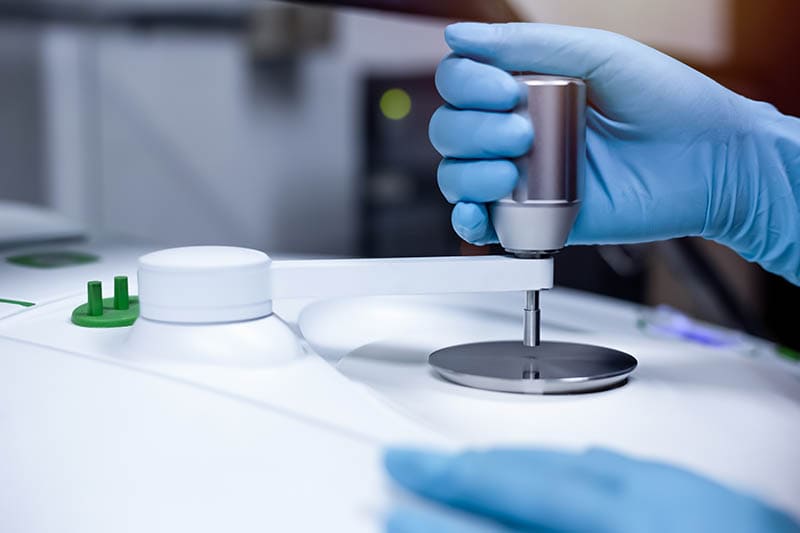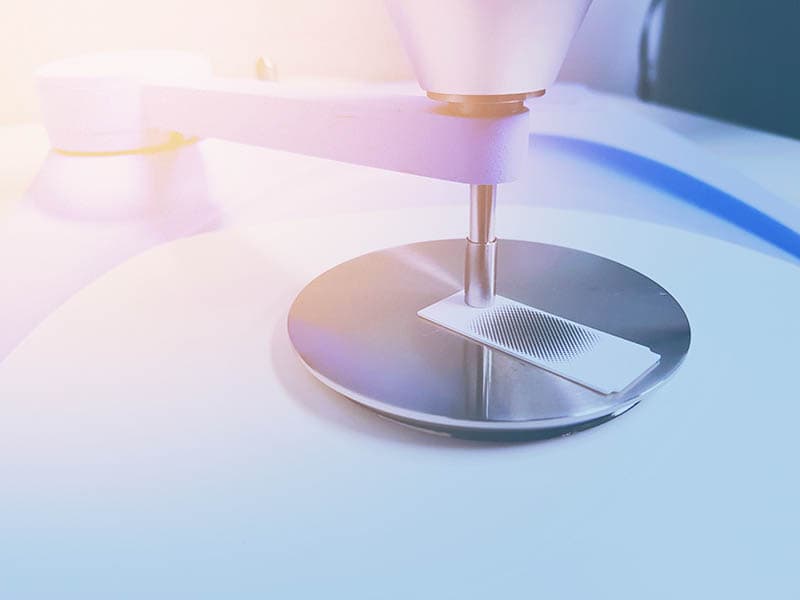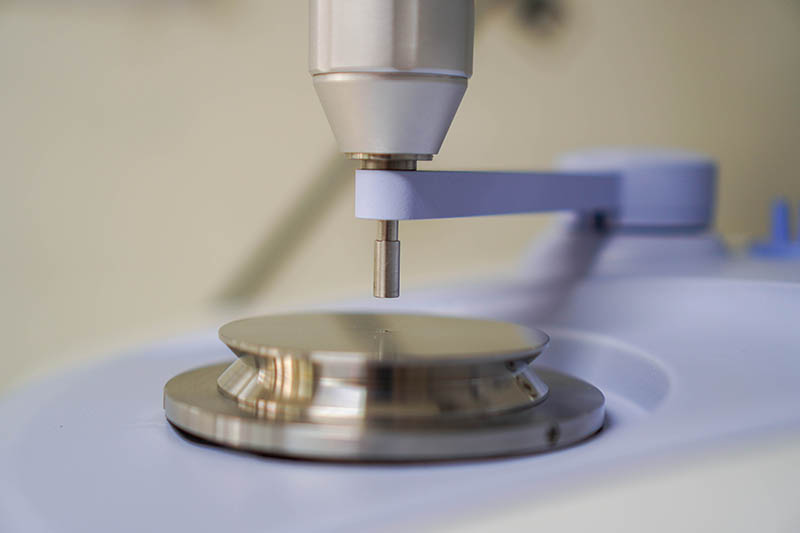What is Infrared Spectroscopy? The Interesting Answer!
Last Updated on

Infrared spectroscopy is an analytical technique that’s used in both scientific research and industry. From identifying organic compounds found at the scene of a crime, to outing forged documents, infrared spectroscopy is one of the most useful technologies ever developed. But how does it work exactly?
Infrared spectroscopy works by studying the interaction between light and matter. By measuring the infrared light that passes through substances, scientists are able to learn more about the structure of the compounds within them. For a more in-depth explanation, keep reading!

How Does It Work?
When a substance is irradiated with infrared, the spectroscopy will show the amount of radiation that passes through the substance, and, therefore, the amount that is absorbed by the molecules at each specific level of infrared energy.
On an infrared spectroscopy graph, the amount of radiation that passes through is shown as transmittance, and it’s measured as a percentage. The frequency or the energy level of the infrared radiation is represented by wavenumbers (in cm-1). For example, if the graph showed 100% transmittance, then at that frequency, no light was absorbed.
In other words, the identity of the atoms within the compound will affect which frequency of infrared, and how much of it, is absorbed. These results are then matched with an established database of functional groups and their infrared range.

What Is Infrared Radiation?
Infrared refers to a band of radiation within the electromagnetic spectrum. Infrared wavelengths are longer than those of visible light, which is why they’re invisible to our eyes.
Infrared wavelengths measure between 1 millimeter (300 gigahertz) and 700 nanometers (430 terahertz). It helps to remember that the amount of energy in electromagnetic waves increases as wavelengths become shorter, and the frequency also increases.
An easy way to visualize this is by imagining two people holding a rope between them. By making slow up and down motions with their hands, they can create wide, low-energy waves. If they exert more energy by making faster movements, the waves become thinner and more frequent.
How Do Molecules React to Infrared Radiation?
Depending on the functional groups in a molecule, the covalent bonds within compounds absorb and react to infrared radiation in different ways, at different wavenumbers—or varying energy levels.
Usually, these bonds are said to vibrate in one of six ways, split across two categories.
Stretching
In stretching, the bonds that hold the atoms to a central atom can stretch to become longer, or shorten to move closer. Imagine drawing a circle, with two stick arms pointing out. It’s the length of these arms that changes.
1. Symmetric stretching
This is where two atoms are simultaneously, and symmetrically, either moving away or towards a central atom, stretching or shortening the bonds in the same way.
2. Asymmetric stretching
In asymmetric stretching, the two atoms are pulling or moving toward the central atom in different directions.
Bending
Whereas stretching refers only to the length of the bond either stretching or shortening, bending refers to the angles of the atoms shifting.
3. Rocking
The easiest way to picture the rocking movement in molecular vibrations, is to imagine the pendulum on a clock rocking back and forth. Here, there are two pendulums (atoms) rocking.
4. Scissoring
When scissoring, atoms are moving towards and away from each other, like a pair of scissors opening and closing.
5. Twisting
This is when two atoms are moving forwards and back, out of the plane, in opposite directions to one another. Imagine a person walking on a treadmill: they would be the central atom, their legs would be the bonds, and their feet would be the twisting atoms.
6. Wagging
The wagging vibration is where the two atoms move simultaneously away and towards each other.

How Do Infrared Spectrometers Work?
After gaining the sample that is to be tested, a chemist will either grind a small amount of the substance with an ionic compound—like potassium bromide—which will not show up in the spectroscopy, or they will mix it with a solvent that gives a known reading in the spectroscopy. The sample is then placed in the correct location to allow the infrared light to pass through it.
There are several types of infrared spectrometers, but they all have a few main features in common. These include a source, an optical system, a detector, and an amplifier.
The source on the spectrometer emits a beam of infrared radiation. The optical system uses a set of mirrors to direct the beam across the correct path. The thermal detectors detect even the slightest changes in radiation.
What Are the Different Types of Infrared Spectrometers?
There are two main types of infrared spectrometers—dispersive infrared spectrometer, and Fourier transform infrared spectrometer. The two devices work on the same principle but in slightly different ways.
In dispersive spectrometers, the source of energy is directed towards a monochromator, which splits the infrared spectrum into various frequencies. Each frequency is then allowed through a slit, and onto the test sample, one at a time.
In Fourier transform infrared spectrometers, the sample is irradiated with the entire infrared spectrum frequencies simultaneously. The infrared beam is split into two, and then recombined with mirrors.

Where Is It Used?
Infrared spectroscopy is used in all kinds of fields. In forensic science, it’s used for identifying various substances, such as sweat, other bodily fluids, and even hairspray on strands of hair. It can be used to analyze the blood-alcohol content of a suspected drunk driver, and it can also be used to identify pigments used in potentially forged documents.
In culture, it’s used to study artifacts, such as illuminated manuscripts, and in the study of valued paintings, to discover underdrawings.
In the food industry, infrared spectroscopy is used to analyze the concentrations of various compounds in edible products.
In the near future, infrared spectrometers may even be embedded into our smartphones and gadgets for personal everyday use.
Advantages of Infrared Spectroscopy
- It’s possible to analyze substances in various forms, including gasses, liquids, solids, powders, etc.
- The data received can include both quantities, and qualitative data—with information about the functional groups, and amount within a sample.
- Infrared spectroscopy is a non-invasive technique of collecting data. Samples do not have to be damaged in the process, and infrared radiation will not harm the environment or surroundings.
Disadvantages of Infrared Spectroscopy
- Infrared spectroscopy is very sensitive. Thus, the equipment must be finely tuned.
- It is not possible to tell a substance’s molecular weight with infrared spectroscopy.
- It’s difficult to analyze aqueous solutions because water absorbs infrared radiation.

A Quick Reference Guide
In this quick reference guide, we list some of the most common functional groups and the infrared range that they are associated with.
| Compound Class | Infrared Range (cm-1) |
| Alcohols | 3200–3650 |
| Alkenes | 2850–3000 |
| Carboxylic Acid | 3300–2500 |
| Sulfate | 1415–1380 |

Final Thoughts
Infrared spectroscopy is the analysis of substances through infrared radiation. Because different molecules absorb infrared at specific frequencies, scientists can analyze the amount of infrared that is not absorbed, and learn more about the molecular structure of the substance.
This analytical technique is used in all aspects of our lives—for example, in food production, astronomy, and forensic science.
Featured Image Credit: S.Singha, Shutterstock
About the Author Cheryl Regan
Cheryl is a freelance content and copywriter from the United Kingdom. Her interests include hiking and amateur astronomy but focuses her writing on gardening and photography. If she isn't writing she can be found curled up with a coffee and her pet cat.
Related Articles:
What Is the Best Binocular Magnification for Hunting? Optical Features Explained
How to Clean a Refractor Telescope: Step-by-Step Guide
How to Clean a Telescope Eyepiece: Step-by-Step Guide
How to Clean a Rifle Scope: 8 Expert Tips
Monocular vs Telescope: Differences Explained (With Pictures)
What Is a Monocular Used For? 8 Common Functions
How to Clean a Telescope Mirror: 8 Expert Tips
Brightfield vs Phase Contrast Microscopy: The Differences Explained
